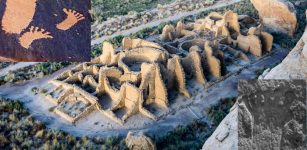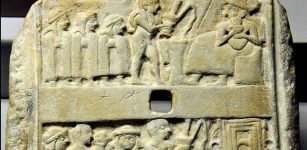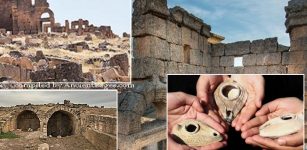Chalchihuitlicue: Beautiful, Dangerous, Changeable And Unpredictable Water Goddess In Aztec Mythology
A. Sutherland - AncientPages.com - From the beginning of human history, water has held a significant role in people's belief systems. Long ago, they realized that they couldn't live without it.
Chalchiuhtlicue Aztec Goddess Of Water (Musée du quai Branly). Image credit: Sailko - CC BY-SA 3.0 DEED
They also recognized the profound influence of water on nature as a whole. Even our ancestors acknowledged water as one of the four fundamental elements, which, together with earth, fire, and air, constituted their understanding of the world's order. Water was personified in almost every culture and was worshiped as a powerful deity. People turned to their powerful deities during times of both scarcity and abundance of water, during droughts and floods alike.
Like in many cultures worldwide, also the inhabitants of what we today call Mesoamerica, worshiped the deities closely associated with water. These divine figures had once a most important position in the pantheon of gods.
Chalchihuitlicue, who represented the advanced civilization of the city of Teotihuacan, was a young goddess. Beautiful and dangerous, changeable and at the same time unpredictable, Chalchihuitlicue had water as her predominant element. She watered the earth, promoting fertility, and flooded it, causing destruction and death of people and animals.
Legends usually vary; in one of them, Chalchuihtilcue is the wife of Tlaloc, but in another she is his sister. Among some other scholars, Chalchuihtilcue is the god Tlaloc himself in disguise. Anyway, she is the one who governs over rivers, lakes, horizontal waters, and streams. Translated as ‘She of the Jade Skirt’, the goddess’ name came from the word ‘Chalchuitl’ (in Nahuatl language: jade). Her name was, therefore, a metaphorical allusion to the blue-green waters of the tropical ocean, shining like the colors in the precious stone.
Perhaps because of its association with water, jade was the most valued rock in Mesoamerica.
Illustration of Chalchiuhtlicue, one of the deities described in the Codex Borgia. Image credit: Unknown - Public Domain
Chalchiutlicue was often held responsible for floods and storms on the seas. Additionally, her female aspect linked her with the watery nature of the womb, and therefore, she played a vital role in the birth and traditional baptismal ceremonies.
The Aztecs (like other agricultural societies) depended heavily on water for their and land’s survival, so the Aztecs always asked Chalchiutlicue for a good harvest of crops.
She was highly revered in the Aztec culture at the time of the Spanish conquest, and she was an important deity figure in the Postclassic Aztec realm of central Mexico in the post-classic period from 1300 to 1521.
Interestingly, some still believe that the presence of this powerful goddess still persists in modern Mexican folklore. Did Chalchiutlicue’s association with Chalchiuhtlatonal, another Aztec water god, also survive to modern times?
His area of special protection included the sea and the animals living in it.
Drawing of (Mesoamerican deity) Chalchiutlicue from (17th century manuscript) Codex Ríos. Chalciutlicue is shown with implements of spinning and weaving. The figures swimming in the stream emanating in her dress could be read as offspring or as those being carried away toward death. Image credit: Unknown author – Public Domain
Ancient tradition has it that god Chalchiuhtlatonal grants one human the gift of water every 10,000 years to help look after the sea.
Chalchiutlicue is depicted in several central Mexican manuscripts, including the Pre-Columbian Codex Borgia, the 16th century Codex Borbonicus, the 16th century Codex Ríos, and the Florentine Codex.
In Aztec art, craftsmen usually carved her sculptures using green stone like jade or similar green stones with respect to her name.
In pre-Columbian and colonial codices, the goddess is described as wearing a bluish-green skirt, from which flows a long, abundant stream of water. Her skirt is like seawater additionally ornamented with water lilies.
National Museum of Anthropology in Mexico City. Aztec mask of Chalchuihtlicue, goddess of water. Image credit: Wolfgang Sauber - CC BY-SA 3.0
Her depictions also emphasize a green stone necklace hanging from her neck and a blue cap with beautiful quetzal feathers on the goddess’s head. Other accents of her outfit include turquoise-colored clappers and earplugs.
Chalchuihtilcue ( “She of the Skirt of Precious Stones”) was believed to be the goddess of running water and was also known as Matlalcueitl (Matlacueye) - “She of thee Blue Skirt”). This name she shares with the mountain peak, today known as “La Malinche”, an inactive volcano (dormant for the last 3,100 years), which is the sixth-highest in Mexico.
From the Aztec theogony we learn that the Third Age of the universe had been under the rule of Tlaloc, the rain god while the Fourth Age was governed by Chalchihuitlicue. The age of Tlaloc ended by fire coming from volcanoes in fiery eruption. Tradition says that the people who lived in those days were turned into butterflies and birds. The Fourth Age of Chalchihuitlicue ended in a terrible flood which turned humankind into fishes. Water, therefore, is seen here in its destructive aspect and may well be an instrument of death.
Written by – A. Sutherland - AncientPages.com Senior Staff Writer
Copyright © AncientPages.com All rights reserved. This material may not be published, broadcast, rewritten or redistributed in whole or part without the express written permission of AncientPages.com
Expand for referencesReferences:
A. Sutherland, "Aztecs’ Five Suns Creation Myth And Prophecy"
Hall Linda B., “Visions of the Feminine: The Dual Goddesses of Ancient Mexico.” Southwest Review 63, no. 2 (1978): 133–42.
Arnold, Philip P. “Paper Ties to Land: Indigenous and Colonial Material Orientations to the Valley of Mexico.” History of Religions 35, no. 1 (1995): 27–60.
Bošković, Aleksandar. “In the Age of the Fifth Sun: Jacques Soustelle’s Studies of Aztec Religion.” Anthropos 87, no. 4/6 (1992): 533–37.
More From Ancient Pages
-
 King Ferdinand’s Secret Code Deciphered After 500 Years
Archaeology | Feb 14, 2018
King Ferdinand’s Secret Code Deciphered After 500 Years
Archaeology | Feb 14, 2018 -
 Jure Grando – First ‘Real’ Historical Vampire Case Documented
Featured Stories | Jun 16, 2021
Jure Grando – First ‘Real’ Historical Vampire Case Documented
Featured Stories | Jun 16, 2021 -
 Huge Ancient Roman Kovachevsko Kale Fortress And Discovery Of A Horreum In Bulgaria
Civilizations | Dec 15, 2015
Huge Ancient Roman Kovachevsko Kale Fortress And Discovery Of A Horreum In Bulgaria
Civilizations | Dec 15, 2015 -
 Ancient People In Chaco Canyon Who Had Six Fingers And Six Toes Were Special – Researchers Say
Archaeology | Mar 16, 2022
Ancient People In Chaco Canyon Who Had Six Fingers And Six Toes Were Special – Researchers Say
Archaeology | Mar 16, 2022 -
 Ur – One Of The Largest And Most Important Cities Of Ancient Mesopotamia
Featured Stories | Jul 28, 2021
Ur – One Of The Largest And Most Important Cities Of Ancient Mesopotamia
Featured Stories | Jul 28, 2021 -
 1,500-Year-Old Ancient Lamps Unearthed In Zerzevan Castle In Southeast Turkey
Archaeology | Nov 25, 2019
1,500-Year-Old Ancient Lamps Unearthed In Zerzevan Castle In Southeast Turkey
Archaeology | Nov 25, 2019 -
 Ancient Pottery Found On The European Atlantic Coast Sheds Light On Cooking In The Bronze Age
Archaeology | Jan 16, 2024
Ancient Pottery Found On The European Atlantic Coast Sheds Light On Cooking In The Bronze Age
Archaeology | Jan 16, 2024 -
 Mystery Of Egyptian Queen Hetepheres I’s Bracelets Solved!
Archaeology | Jun 2, 2023
Mystery Of Egyptian Queen Hetepheres I’s Bracelets Solved!
Archaeology | Jun 2, 2023 -
 Mystery Of The Kappas That Moved Swiftly Over The Waters Or Across The Sky
Japanese Mythology | Jun 16, 2014
Mystery Of The Kappas That Moved Swiftly Over The Waters Or Across The Sky
Japanese Mythology | Jun 16, 2014 -
 Ancient Egyptians Had A Different Definition Of ‘Foreigners’
Ancient History Facts | Apr 14, 2018
Ancient Egyptians Had A Different Definition Of ‘Foreigners’
Ancient History Facts | Apr 14, 2018 -
 New Chemical Reactions To Generate Building Blocks Of Proteins And DNA – Discovered
DNA | Jul 29, 2022
New Chemical Reactions To Generate Building Blocks Of Proteins And DNA – Discovered
DNA | Jul 29, 2022 -
 Cup Of Jamshid – Holy Grail Of Ancient Persia Offered Immortality And Visions Of The Future
Featured Stories | Jan 16, 2019
Cup Of Jamshid – Holy Grail Of Ancient Persia Offered Immortality And Visions Of The Future
Featured Stories | Jan 16, 2019 -
 Trolls – Fascinating Mythical Creatures Of Scandinavia
Featured Stories | Jun 13, 2022
Trolls – Fascinating Mythical Creatures Of Scandinavia
Featured Stories | Jun 13, 2022 -
 Okanagan Indians’ Myth Of A Lost Island Paradise Inhabited By White Giants – Are Their Descendants Living In British Columbia?
Featured Stories | Dec 29, 2020
Okanagan Indians’ Myth Of A Lost Island Paradise Inhabited By White Giants – Are Their Descendants Living In British Columbia?
Featured Stories | Dec 29, 2020 -
 What Was The Extreme Ritual Of Sokushinbutsu?
Ancient Traditions And Customs | Jun 20, 2018
What Was The Extreme Ritual Of Sokushinbutsu?
Ancient Traditions And Customs | Jun 20, 2018 -
 Man In Sweden Finds Viking Age Skeleton In His Garden
Archaeology | Jun 30, 2023
Man In Sweden Finds Viking Age Skeleton In His Garden
Archaeology | Jun 30, 2023 -
 Phurba Dagger: Magical Weapon That Restrains Evil And Harmful Occult Forces
Artifacts | Mar 16, 2019
Phurba Dagger: Magical Weapon That Restrains Evil And Harmful Occult Forces
Artifacts | Mar 16, 2019 -
 3,500-Year-Old Tomb Discovered In Luxor – Who Is The Royal Buried Inside?
Archaeology | Jan 16, 2023
3,500-Year-Old Tomb Discovered In Luxor – Who Is The Royal Buried Inside?
Archaeology | Jan 16, 2023 -
 Unique 3,000-Year-Old Logboat Found In River Tay – On Display In Perth, Scotland Again
Archaeology | Oct 30, 2023
Unique 3,000-Year-Old Logboat Found In River Tay – On Display In Perth, Scotland Again
Archaeology | Oct 30, 2023 -
 Vast Network Of Previously Unknown European Bronze Age Megastructures Discovered
Archaeology | Nov 20, 2023
Vast Network Of Previously Unknown European Bronze Age Megastructures Discovered
Archaeology | Nov 20, 2023




